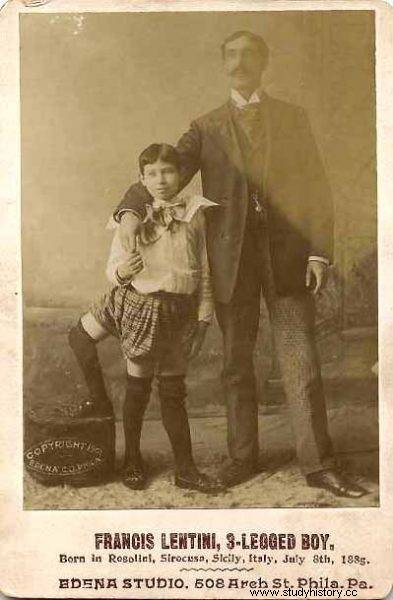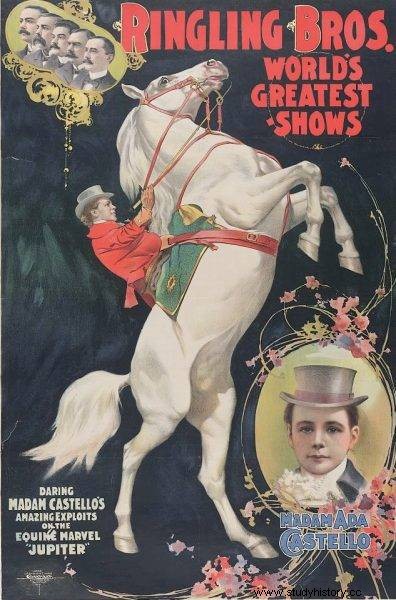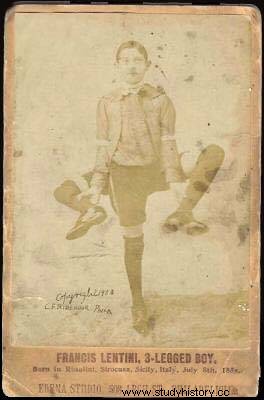Frank Lentini was a famous artist, he married twice and fathered four children. He was distinguished from others by his above-average charisma, three legs and ... two penises.
Heteropagus parasitic is a very rare disease. To put it simply, in utero, one of the identical twins developing in the womb is partially absorbed by its brother or sister. When such a baby is born, he is usually more or less deformed. Has extra limbs or other body parts "inherited" from siblings . In the past, people with this condition were considered freaks, freaks of nature. They often lived a life full of pain and suffering. There have, however, been exceptions in history. Some became respected and recognizable people. One of them was Frank Lentini. He turned his difference into an asset. His unusual physiognomy provided him with an interesting and prosperous life.
Nasty
Frank (Francesco) Lentini was born in 1889 in Syracuse, Sicily. Apparently, the midwife who was delivering the baby started screaming when she saw the baby . She hid it in a basket under the bed and ran out of the room. The boy was born with three legs, four feet, sixteen fingers, and two "sets" of genitals. Apart from the remains of the twin, which had become part of his own body, Frank had twelve more siblings. Due to his physical blemish, he was initially spurned by his biological parents. The little boy was brought up by his aunt. In the village where he lived, the boy was harassed and mocked . Gained the nickname "Maravigghia" ("The Poorous") .

In the village where he lived, the boy was harassed and ridiculed. He was nicknamed "Maravigghia" ("The Vile").
At the age of several, he was temporarily placed in a shelter for disabled children. He hated his additional members, but when he saw the other sick, realized his life could have been much worse . In the workhouse, he had contact with children who were not able to function normally. Frank, meanwhile, was fully independent. He could not only walk and run, but also play football, jump rope, ride a bike or skate.
As an adult male, Lentini repeatedly referred to this period as a time in which accepted his difference and learned to enjoy life despite his physical limitations . The medicine of that time was not able to help him. The doctors examining Frank feared that the removal of the extra leg would paralyze the boy. With time, however, "learned" his body. When his extra limb stopped growing and no longer reached the ground, he tied it to the next leg. His mother sewed him non-standard pants and ordered three special shoes from the shoemaker. His life took color when he and his family - like hundreds of thousands of other Italians - emigrated to the United States in the early 20th century.
The American dream
When the ship with 9-year-old Frank entered the port in the American city of Bridgeport in 1898, the USA appeared to emigrants from Europe as a place where anything is possible. The crippled Italian boy did not realize at the time that his life would soon become an example of the American dream of abundance. All because of the growing taste of Americans for viewing all kinds of "museums of curiosities" and "freak shows".
Back then, nothing was wrong with the financial gain of presenting physically handicapped people to the public. When viewed through the prism of today's moral standards, such actions may be considered reprehensible. However, it should be remembered that for the sick and endowed with unusual physiognomy, it was often the only chance for a prosperous life at that time. Of course, there were also cases of abuse, manipulation and mistreatment of sick artists. But the biggest stars of the American freak show turned into celebrities. They enjoyed considerable fame and fortune.

Shortly after arriving in the US, he began performing at the Ringling Brothers
circusRecognition and fortune were also written for little Francesco. Shortly after arriving in the US, began performing at the Ringling Brothers circus - one of the most famous in America. He delighted the audience with his extraordinary agility and control over the extra limb, which he showed best when playing football. Lentini's career took off when he made his debut at the Barnum Circus in 1906 in Madison Square Garden in New York, and later in Buffalo Bill's famous Wild West Show . He has toured the United States and Europe several times, where he was portrayed as "Sicilian Three-legged", "The only three-legged footballer in the world", "The greatest wonder of medicine of all time" or simply "The Great Lentini".
A charismatic man
The third leg distinguished Lentini from the rest of society, but he would not have achieved the status of a great circus star without his other virtues:charisma and sharp mind. He mastered the English language perfectly and used his extra limb as a stool during interviews you can lean on. With eagerness and erudition, he described both the backstage of circus life and curiosities related to the sexual life of a man endowed with an extra pair of genitals .
He had a great sense of humor and distance to his handicaps. When asked by a journalist, "Is it difficult to buy three of the same shoes?" Lentini replied, "I bought two of the same pairs and gave one shoe to my one-legged friend."

He delighted the audience with his extraordinary agility and control over the extra limb
Disability did not stand in the way of his relations with the fair sex. Using his extraordinary charisma, he seduced a young actress, Theresa Murray, in 1907. Soon after, the couple got married. Mrs. Murray gave Summer four children:Josephine, Natale, Franceso Jr. and Giacomo. Frank and Teresa finally broke up in 1935, but the artist quickly found a new love. He spent the rest of his life with Helen Shupe. He died of lung failure at the age of 77 in 1966.
Life is beautiful
At the end of his life, Great Lentini could no longer count on fame and a satisfactory earnings. The era of "museums of curiosities" ended in the US in the middle of the 20th century. Cinema, television and radio began to provide Americans with much more interesting entertainment. But the most important factor that made the "freak show" disappear was the morality of this type of show.

At the end of his life, Great Lentini could no longer count on fame and a satisfactory earnings.
However, whether we like it or not, the biggest stars of this type of shows, such as Fedor Jeftichew - a man with the face of a dog, the tattooed Captain Costentenus or the Siamese brothers Chang and Eng Bunker have forever entered the history of entertainment. The world also remembers Frank Lentini to this day. In 2016, i.e. 50 years after the artist's death, a two-day festival in his memory was held in his hometown in Sicily. The 2017 musical "The Greatest Showman" also nodded to him, with actor Jonathan Redavid portraying the artist in an episodic scene.
"I think life is beautiful and I like to live it," Francesco Lentini used to say. These words show that what is most important in the history of the three-legged artist was his ability to overcome his physical handicaps and the will to pursue his dream of a normal life.
Bibliography:
- Silverman, Meet Frank Lentini, The Sideshow Performer With Three Legs, 16 Fingers, And Two Penises, allthatsinteresting.com (accessed 04/12/2022).
- Crockett, The Rise and Fall of Circus Freakshows, priceonomics.com (accessed 4/12/2022).
- Talmon, Facts And Stories About Frank Lentini, The 'Three-Legged Man', ranker.com (accessed 04/12/2022).
- Meehan, Francesco A. Lentini, Three Legged Wonder, wethersfieldhistory.org (accessed April 13, 2022).
